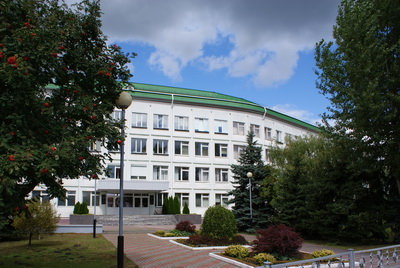State Scientific Institution “Institute of Radiobiology of the National Academy of Sciences of Belarus” (IRB NASB, or IRB) implements its scientific, organizational and research activities in accordance with NASB Presidium Decree No. 1 of 13 January 2005 “On Qualification Approval of Institute of Radiobiology” and is entrusted with the missions set forth therein covering the following research areas:
– assessment and prediction of long-term biomedical effects of ionizing radiation;
– studying the combined health effects from radiation and non-radiation (e.g. electromagnetic) factors, development of protective measures;
– radioecological monitoring, assessment of environmental radioactive contamination and its effects on plants and animals, development of methods for sustainable use of natural resources;
– studying the processes of how various radionuclides (incl. transuranic elements) enter the food chains under radioactive conditions, behave and accumulate in living organisms, and how they contribute to forming the radiation doses; elaboration of the ways to manipulate these processes in order to limit associated adverse effects.
Following the acceptance of the national top-priority R&D trends, NASB Presidium Decree No. 73 of 20 October 2006 established IRB’s major lines of scientific, technical, fundamental and applied research activities as follows:
- Priority areas in terms of scientific and technical activities:
– Medicine & Pharmacy: development of new preventive treatment technologies based on biologically active supplements, other medicine remedies;
– Environment & Natural Resources: environmental monitoring and forecasts, remediation of radioactively contaminated lands.
- Priority areas in terms of fundamental and applied research:
– New Treatment, Diagnostic, Prophylactic and Recovery Techniques, Tools, Devices, Medical Products and Immunobiological Preparations, Cellular and Biomolecular Technologies: human body adaptive mechanisms towards environmental impacts and against the effects of ionizing radiation;
– Environmental Safety, Environmental Protection, Mineral Resources, Subsurface Riches of Belarus, Substantial Use of Natural Resources, Emergency Prevention, Response and Recovery: protective measures against long-term radioecological consequences of the Chernobyl disaster.
As of today, IRB operates 7 laboratories:
– Radioecology;
– Endocrinology & Biochemistry;
– Anthropogenic Risk Modelling and Minimization;
– Combined Effects;
– Experimental Biological Models;
– Environmentally Safe Animal Production under Technogenic Contamination Conditions;
– Agroecology and Mass Analyses.
